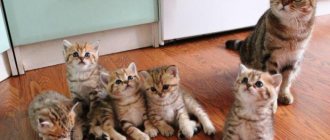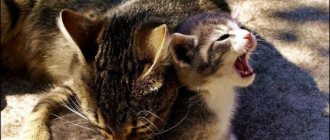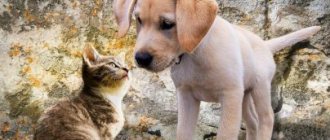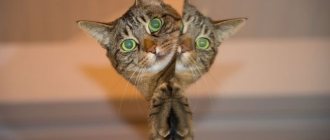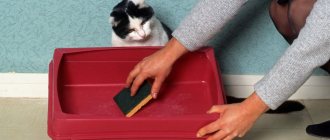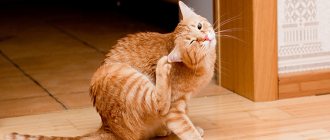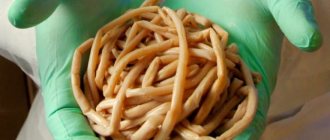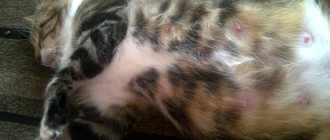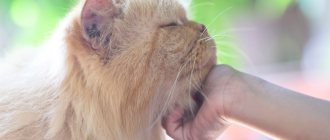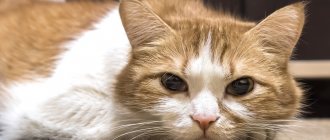Cats from the same litter can have different colors, patterns, sizes and even breeds. The only explanation is that the kittens have different fathers.
Cat litters can have more than one father due to superfecundation. Egg production in female cats is caused by mating. When a female produces multiple eggs and mates multiple times, the eggs may be fertilized by different fathers. Kittens are born in the same litter.
This is possible thanks to the unusual method of breeding cats. And what makes this process even more fun is that there can be more than two fathers in a litter.
Frequent cat pregnancy
- Will Mura come out?
Since the birth of one kitten embryo requires one egg (from the mother cat) and one sperm (from the father cat), the number of embryos depends on how many mature eggs will be fertilized. If, say, five eggs have matured in a cat’s body, and all have been fertilized, then in a couple of months five lovely kittens will be born.
The trick is that not all eggs mature at the same time (!), and therefore several cats can take part in their fertilization. In this case, the kittens will be from different fathers. It will probably be a little difficult to figure out the genes here - some from mom, some from dad, but which one?
A little medicine. Estrus is the stage of a cat's reproductive cycle during which ovulation occurs (the release of an egg from the ovary into the abdominal cavity). A mature egg is capable of fertilization within 12-48 hours. Sperm can exist inside the female's body for 4-5 days. It is characteristic that ovulation in a cat occurs after mating, which serves as a stimulus for the release of eggs. On average, the number of eggs varies from 3 to 7. It is all these numbers that make it possible for several eggs to be fertilized by different sperm during one ovulation period (i.e. one estrus).
But that is not all!
Albino cat breeds
Albinos can appear among different breeds. And yet there are breeds among which such individuals appear much more often. Some breeds even appeared as a result of breeding individuals with albinism. It is not easy to get snow-white individuals, because a recessive gene is responsible for this color. In addition, during the selection process there is a high number of cullings. Since the albinism gene often leads to deafness, animals with hearing impairment cannot subsequently participate in breeding.
Breeders rarely use individuals with complete albinism for breeding, as they have a number of health problems, which can only intensify during the selection process. But the gene for partial albinism is found in many breeds. Due to selection, the following breeds can boast a completely white color: Turkish Angora, Foreign White, Kao Mani. There are also breeds among which individuals with incomplete albinism are much more common - these are the Siamese, Burmese, Thai, Balinese, Tonkinese and Himalayan.
Khao-mani
The breed comes from Thailand. It is very rare and considered expensive. These are snow-white cats with short hair. Their main feature for which the breed is valued is their multi-colored eyes. There are individuals with the same eye color, but cats with heterochrony are valued much more. In Thailand they are believed to bring good luck.
Kittens are often born with a small dark spot on their head that fades over time. With age, the animal becomes completely white. Most individuals have hearing problems. They are often deaf in the ear on the side of the blue eye.
Foreign white
This breed is related to Siamese cats. Breeder Patricia Turner from the UK set herself the goal of breeding a cat with the body of a Siamese and snow-white fur. In addition, she set herself the goal of minimizing the appearance of deaf individuals among the representatives of the breed. As a result of long work on selection, the goal was achieved.
Foreign Whites are very similar in character and characteristics to Siamese cats. They are smart and can learn commands. These cats are very talkative. Deaf individuals are practically never found.
How to determine the number of future kittens
There are several ways to find out how many kittens a cat will give birth to. Conventionally, they can be called physiological, folk and scientific methods.
- Physiological. The number of kittens depends on the number of places where fertilized eggs attach to the walls of the uterus.
- People's Experienced cat owners calculate the number of future offspring in a simple way. The number two is subtracted from the number of mammary glands in the female. This method does not give 100% results, but is still often used in practice.
- Scientific. Felinologists recommend checking the expectant mother with an ultrasound a week before the expected birth. Thus, it will be known exactly what kind of offspring to expect. Under no circumstances should you feel your cat's belly with your hands to find out how many kittens she will give birth to. Palpation can damage embryos and lead to psychological stress for the expectant mother.
Answer or solution 2
Each living organism in our nature is unique and cannot be repeated.
During the process of reproduction, the mother's cell merges with the father's cell and one completely new cell is formed - the zygote. This process is accompanied by a random exchange of genes and chromosomes, which is not subject to any external control. In a cat, during the process of ovulation, several small eggs mature, which are fertilized by several sperm. Ultimately, several kittens are born at a time, each with their own unique structure and characteristics. Why are kittens in the same litter different from each other?
Everyone knows that cats are unique animals in many ways; many people even attribute paranormal abilities to them. But some features of these creatures have long been studied and described by scientists.
Theme for breeders. About matings.
At the seminar, the following topic was touched upon: “Can kittens of the same litter have different fathers if the cat was bred by several cats,” to which the reproductive doctor answered categorically “NO.” Although I doubt she is right, it seems to me that anything is possible. And this is what I found on the Internet about this:
“How does a free-range cat fit in?
A bunch of cats are gathering, that’s how many heard and smelled, everyone will be here. at least up to 10-15 per unfortunate lady. And they sit around the ladies - those who are higher in rank are closer, those who are lower - the second and third circle, with an approach not on the first day. And usually several cats knit it at once. One by one. With a break... well, with different breaks - minutes, tens of minutes, hours. we'll see how it goes. The first to knit is usually the main cat of this territory, and those who are bolder and more concerned. Maybe at first only one main cat will knit. the rest will be admitted when he rests.
Or not allowed, because the poor lady will finally wriggle out, quickly run away and hide somewhere in a hole to rest.
The second or third missed circle, waiting for the moment, can jump on each other out of excitement, grab each other by the collar - and have fun. By the way, cats have different attitudes. Some people really don’t like being grabbed like that... Then even a person won’t take them by the scruff of the neck - they will immediately fight back. And some don't mind. Moreover, I saw how such a young, low-ranking old-timer attacked a fairly high-ranking and strong newcomer - and he got away with it.
Well, what if a cat is bred by two or three cats in a row and at that time she is ready for fertilization? Theoretically, a mixture of sperm from different cats is provided for fertilization of eggs. Then it depends on chance and the stars. How the card will fall and the stars will align.
Yes, and eggs can mature at different times... And sperm can be of different activity and a lot more
I saw litter from two cats (well, it seemed to me) - by color. I think this happens often. And then the probability decreases. From three at once? I personally fully admit it, but in the form of rarities and natural coincidences. There are too many positions to combine. So your friend’s statement that if a cat is covered by 5 cats, then each will produce a kitten is incorrect.
A cat can have litters from different cats, but not necessarily from all the cats that bred it. I would say that this cannot be the case...or rather, the likelihood of this is extremely low if there are more than two or three cats.”
“A cat can become pregnant from every cat that breeds her. Or she may not get pregnant at all. That's how the card falls. But only one cat should breed a cat. Otherwise, the litter will end up with a streak and a bow on the side. Such marks are not subject to certification. Not. Well, if the cat is a “domestic” breed, then what difference does it make?” etc., these are statements from breeders.
Features of cat pregnancy
On average, pregnancy in a cat of any variety, be it British shorthair, Scottish fold or fluffy Persian, lasts 62-63 days. If an animal bears offspring and gives birth for the first time, the period may be shorter - 56-58 days. Multiple pregnancies often lead to premature birth, and when a mother cat is carrying one or two babies, she can walk in the position for the maximum period possible. In the latter case, the offspring are born healthier and larger than from a litter with many kittens. Kitting is also easier and faster for a cat, so a low-fertility pregnancy is preferable.
Is there any way to increase the number of kittens in a litter?
Owners of purebred cats who bear 1-3 kittens at a time may face a similar question. The number of kittens can be influenced with the help of medications.
For example, in advance of the planned mating and pregnancy, special preparations of a hormonal or homeopathic nature are added to the pet’s diet. Hormonal medications are prescribed only by a veterinarian after a thorough examination of the cat’s health.
It is important to follow the regimen and dosage of taking hormones, otherwise you can provoke a hormonal imbalance in the female’s body. Homeopathic medicines such as “Gamavit” and “Ovariovit” allow the ovaries to recover and produce healthy, high-quality eggs in greater quantities than before starting the course of taking the drug
Vitamin E and selenium in small doses have a positive effect on the reproduction of the cat's body.
Important to consider! Only a veterinarian can calculate the correct dosage, taking into account the physical characteristics of the cat, so it is not recommended to do this yourself, so as not to harm the health of the pet.
How does the number of babies affect the health of the mother?
Stimulation of multiple pregnancy can lead to the development of unfavorable processes in the body of the cat and its offspring:
- The birth of weak, non-viable offspring. During pregnancy, a large number of embryos cannot always receive a sufficient amount of nutrition, and with it a minimum of useful microelements. The anatomical features of the female may be unsuitable for bearing such an offspring; accordingly, the cubs will not have enough space in the womb, which affects their size.
- Increased risk of complications during childbirth and the postpartum period, which can lead to forced surgery to remove the uterus and ovaries.
- There is a likelihood of a shortage of mother's milk in sufficient quantities for each baby, which will require owners to purchase artificial nutrition. You will also have to take the time to syringe feed the kittens.
A small pregnancy is no less fraught with consequences. For example, one kitten in the womb will receive everything it needs from its mother for several, eventually growing to a large size and getting stuck in the birth canal. And the production of a large amount of milk, which 1-2 cubs simply cannot eat on time, can lead to the development of mastitis.
Announcements on NN.RU - Home
Private master. I repair washing machines at home. I’ll arrive as quickly as possible, I take many spare parts with me, the amount of repairs is up to you. Price: 500 rub.
We work Mon-Sun, 08:00-22:00. Repair of household appliances with on-site service to any district of Nizhny Novgorod and the Nizhny Novgorod region. We react. Price: 500 rub.
The case is well preserved. Condition in the photo. Price: 150 rub.
Monoblock ASUS ET2411INTI-B009C ([90pt00b1000100c] - Current configuration Monitor 23.6″ (59.9 cm), Full HD resolution 1920 x 1080. Price: 18,000 rub.
Source
Why do veterinarians advise adopting kittens from the same litter?
A kitten in the house is happiness, especially for small family members. Children often ask their parents to buy them a kitten so that they can play with it, accustom it to a bowl and tray, stroke it, and carry it in their arms. But sometimes the joy comes immediately in double size when people acquire two kittens from the same litter at once, usually a boy and a girl.
Watching two babies is very touching, especially when they play - bulging round eyes, constantly raised tails, and especially touching voices - a thin squeak, by which the age of the pet is immediately clear: from two weeks to a month. But why do doctors and psychologists recommend taking one year old if you want to have two cats? There are several reasons for this:
